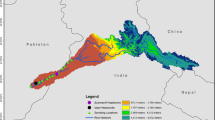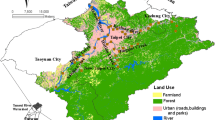Abstract
Pathogens in manure can cause waterborne-disease outbreaks, serious illness, and even death in humans. Therefore, information about the transformation and transport of bacteria is crucial for determining their source. In this study, the Soil and Water Assessment Tool (SWAT) was applied to simulate fecal coliform bacteria load in the Miyun Reservoir watershed, China. The data for the fecal coliform were obtained at three sampling sites, Chenying (CY), Gubeikou (GBK), and Xiahui (XH). The calibration processes of the fecal coliform were conducted using the CY and GBK sites, and validation was conducted at the XH site. An interval-to-interval approach was designed and incorporated into the processes of fecal coliform calibration and validation. The 95% confidence interval of the predicted values and the 95% confidence interval of measured values were considered during calibration and validation in the interval-to-interval approach. Compared with the traditional point-to-point comparison, this method can improve simulation accuracy. The results indicated that the simulation of fecal coliform using the interval-to-interval approach was reasonable for the watershed. This method could provide a new research direction for future model calibration and validation studies.

Similar content being viewed by others
References
Abbaspour KC (2011) SWAT-CUP4: SWAT calibration and uncertainty programs—a user manual. Department of Systems Analysis, Integrated Assessment and Modelling (SIAM), Eawag, Swiss Federal Institute of Aquatic Science and Technology, Switzerland
Abbaspour KC, Yang J, Maximov I, Siber R, Bogner K, Mieleitner J, Zobrist J, Srinivasan R (2007) Modelling hydrology and water quality in the pre-alpine/alpine Thur watershed using SWAT. J Hydrol 333:413–430
Ackerman D, Weisberg SB (2003) Relationship between rainfall and beach bacterial concentrations on Santa Monica bay beaches. J Water Health 1:85–89
ASAE (2000) Standard D384.1: manure production and characteristics. American Society of Agricultural Engineers, St. Joseph
Baffaut C, Benson VW (2009) Modeling flow and pollutant transport in a karst watershed with SWAT. Trans ASABE 52(2):469–479
Baffaut C, Sadeghi A (2010) Bacteria modeling with SWAT for assessment and remediation studies: a review. Trans ASABE 53(5):1585–1594
Bai J, Shen Z, Yan T (2016) Effectiveness of vegetative filter strips in abating fecal coliform based on modified soil and water assessment tool. Int J Environ Sci Te 13(7):1723–1730
Baldassarre GD, Montanari A (2009) Uncertainty in river discharge observations: a quantitative analysis. Hydrol Earth Syst Sci 13:913–921
Bao ZX, Fu GB, Wang GQ, Jin JL, He RM, Yan XL, Liu CS (2012) Hydrological projection for the Miyun reservoir basin with the impact of climate change and human activity. Quatern Int 282:96–103
Benham BL, Baffaut C, Zeckoski RW, Mankin KR, Pachepsky YA, Sadeghi AM, Brannan KM, Soupir ML, Habersack MJ (2006) Modeling bacteria fate and transport in watersheds to support TMDLS. Trans ASABE 49(4):987–1002
Bougeard M, Le Saux JC, Perenne N, Baffaut C, Robin M, Pommepuy M (2011) Modeling of Escherichia coli fluxes on a catchment and the impact on coastal water and shellfish quality. J Am Water Resour As 47(2):350–366
Chen L, Shen ZY, Yang XH, Liao Q, Yu SL (2014) An interval-deviation approach for hydrology and water quality model evaluation within an uncertainty framework. J Hydrol 509:207–214
Cho KH, Pachepsky YA, Kim JH, Kim JW, Park MH (2012) The modified SWAT model for predicting fecal coliforms in the Wachusett reservoir watershed, USA. Water Res 46:4750–4760
Coffey R, Cummins E, Flaherty VO, Cormican M (2010) Analysis of the soil and water assessment tool (SWAT) to model cryptosporidium in surface water sources. Biosyst Eng 106:303–314
Eisenhart C, Wilson PW (1943) Statistical methods and control in bacteriology. Bacteriol Rev 7(2):57–137
Fayer R, Trout JM (2005) Zoonotic protists in the marine environment. Oceans and Health: Pathogens in the Marine Environment. Kluwer Academic Publishers, Dordrecht, pp 143–163
Franz KJ, Hogue TS (2011) Evaluating uncertainty estimates in hydrologic models: borrowing measures from the forecast verification community. Hydrol Earth Syst Sci 15:3367–3382
Frey SK, Topp E, Edge T, Fall C, Gannon V, Jokinen C, Marti R, Neumann N, Ruecker N, Wilkes G, Lapen DR (2013) Using SWAT, Bacteroidales microbial source tracking markers, and fecal indicator bacteria to predict waterborne pathogen occurrence in an agricultural watershed. Water Res 47:6326–6337
Goss M, Richards C (2008) Development of a risk-based index for source water protection planning, which supports the reduction of pathogens form agricultural activity entering water resources. J Environ Manag 87:623–632
Haan CT, Allred B, Storm DE, Sabbagh GJ, Prabhu S (1995) Statistical procedure for evaluating hydrologic/water quality models. Trans ASABE 38:725–733
Harmel RD, King KW (2005) Uncertainty in measured sediment and nutrient flux in runoff from small agricultural watersheds. Trans ASABE 48:1713–1721
Harmel RD, Smith PK (2007) Consideration of measurement uncertainty in the evaluation of goodness-of-fit in hydrologic and water quality modeling. J Hydrol 337:326–336
Harmel RD, Smith PK, Migliaccio KW (2010) Modifying goodness-of-fit indicators to incorporate both measurement and model uncertainty in model calibration and validation. Trans ASABE 55:55–63
Howden NJK, Burt TP, Mathias SA, Worrall F, Whelan MJ (2011) Modelling long-term diffuse nitrate pollution at the catchment-scale: data, parameter and epistemic uncertainty. J Hydrol 403:337–351
Huang J, Bao L, Guan Y (1994) MPN value of the coliform group measured by multi-tube method–a study of HBG programme. Journal of Jilin Institute of Chemical Technology 11(2):24–27 (in Chinese)
Hyer KE, Moyer DL (2003) Patterns and sources of fecal coliform bacteria in three streams in Virginia, 1999–2000. US Geological Survey, water-resources investigations report 03–4115. U.S. Geological Survey, Washington, DC
Islam M, Jennie M, Doyle MP, Jiang XP (2004) Fate of Escherichia coli O157:H7 in manure compost-amended soil and on carrots and onions grown in an environmentally controlled growth chamber. J Food Prot 67(3):574–578
Kim JW, Pachepsky YA, Shelton DR, Coppock C (2010) Effect of streambed bacteria release on E. coli concentrations: monitoring and modeling with the modified SWAT. Ecol Model 22:1592–1604
Ma H, Yang D, Tan SK, Gao B, Hu Q (2010) Impact of climate variability and human activity on streamflow decrease in the Miyun reservoir catchment. J Hydrol 389:317–324
McCrady MH (1915) The numerical interpretation of fermentation tube results. J Infect Dis 17:183–212
McDaniel RL, Soupir ML, Tuttle RB, Cervantes AE (2013) Release, dispersion, and resuspension of Escherichia coli from direct fecal deposits under controlled flows. J Am Water Resour As 49(2):319–327
Middleton JH, Ambrose A (2005) Enumeration and antibiotic resistance patterns of fecal indicator organisms isolated from migratory Canada geese (Branta canadensis). J Wildlife Dis 41(2):334–341
Moriasi D, Arnold J, Liew MWV, Bingner RL, Harmel RD, Veith TL (2007) Model evaluation guidelines for systematic quantification of accuracy in watershed simulations. Trans ASABE 50(3):885–900
Moyer DL, Hyer KE (2003) Use of the hydrological simulation program—FORTRAN and bacterial source tracking for development of the fecal coliform total maximum daily load (TMDL) for Christians Creek, Augusta County, Virginia. Water-resources investigations report no. 03-4162. U.S. Geological Survey, Washington, DC
Nash J, Sutcliffe J (1970) River flow forecasting through conceptual models part I—a discussion of principles. J Hydrol 10:282–290
Parajuli P, Mankin KR, Barnes PL (2007) New methods in modeling source-specific bacteria at watershed scale using SWAT. In: Proceedings of the watershed management to meet water quality standards and total maximum daily load (TMDLs). ASABE Publication No. 701P0207. ASABE, St. Joseph
Parajuli PB, Mankin KR, Barnes PL (2008) Applicability of targeting vegetative filter strips to abate fecal bacteria and sediment yield using SWAT. Agr Water Manage 95:1189–1200
Parajuli PB, Mankin KR, Barnes LP (2009a) Source specific fecal bacteria modeling using soil and water assessment tool model. Bioresour Technol 100:953–963
Parajuli PB, Douglas-Mankin KR, Barnes PL, Rossi CG (2009b) Fecal bacteria source characterization and sensitivity analysis of SWAT 2005. Trans ASAE 52:1847–1858
USEPA (U.S. Environmental Protection Agency) (1986) Ambient Water Quality Criteria for Bacteria—1986. Bacteriological ambient water quality criteria for marine and fresh recreational waters. Office of Research and Development, Microbiology and Toxicology Div., Cincinnati Ohio and Office of Water Regulations and Standards, Criteria and Standards Division, Washington, D.C. EPA–440/5–84–002
Whitman RL, Przybyla-Kelly K, Shively DA, Nevers MB, Byappanahalli MN (2008) Sunlight, season, snowmelt, storm, and source affect E. coli populations in an artificially ponded stream. Sci Total Environ 390:448–455
WHO/UNICEF (2000) Global water supply and sanitation assessment 2000 report (online). World Health Organization and United Nations Children’s Fund, New York
WHO/UNICEF (2014) Progress on drinking water and sanitation. World Health Organization and United Nations International Children’s Emergency Fund, Geneva
Wu YF (2009) Journal of animals in Heibei Province. Hebei science and technology press, Hebei (in Chinese)
Xu ZX, Pang JP, Liu CM, Li JY (2009) Assessment of runoff and sediment yield in the Miyun reservoir catchment by using SWAT model. Hydrol Process 23:3619–3630
Yang Q, Tam NFY, Wong YS, Luan TG, Su WS, Lan CY et al (2008) Potential use of mangroves as constructed wetland for municipal sewage treatment in Futian, Shenzhen, China. Mar Pollut Bull 57:735–743
Yen H, Hoque YM, Harmel RD, Jeong J (2015) The impact of considering uncertainty in measured calibration/validation data during auto-calibration of hydrologic and water quality models. Stoch Environ Res Risk Assess 29:1891–1901
Zheng CC, Zhou LX (2013) Antibacterial potency of housefly larvae extract from sewage sludge through bioconversion. J Environ Sci 25(9):1897–1905
Acknowledgements
The research was funded by the National Natural Science Foundation of China (No. 51579011), National Science Foundation for Innovative Research Group (No. 51421065), and State Key Program of National Natural Science of China (No. 41530635).
Author information
Authors and Affiliations
Corresponding author
Additional information
Responsible editor: Philippe Garrigues
Rights and permissions
About this article
Cite this article
Bai, J., Shen, Z., Yan, T. et al. Predicting fecal coliform using the interval-to-interval approach and SWAT in the Miyun watershed, China. Environ Sci Pollut Res 24, 15462–15470 (2017). https://doi.org/10.1007/s11356-017-9101-7
Received:
Accepted:
Published:
Issue Date:
DOI: https://doi.org/10.1007/s11356-017-9101-7




